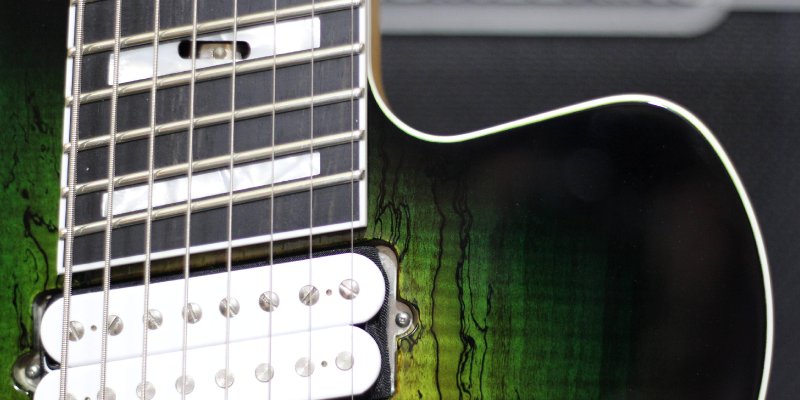
A Look at 7 and 8 String Guitars
By Shawn Leonhardt for Guitar Tricks and 30 Day Singer
For those who haven’t looked too closely at guitars with more than 6 strings, there is a new world of sonic possibilities when you add more on. When learning guitar it’s best to take different approaches and a new or augmented instrument is a great start in providing another perspective. We will look at some more details of 7 and 8 string guitars and see what sets them apart from their average 6 string counterparts.
The Build of 7 and 8 String Guitars
Musicians have used a variety of different stringed guitars over the years, the tenor guitar was popular in the early 1900’s and only had 4 strings. Before the advent of the electric guitar we had ukuleles, mandolins, and guitars mixed in a variety of bodies and builds. In some cases a harp was added for drones and extra bass strings, but eventually Rock n Roll hit and the 6-string electric became the standard.
While many artists found they could bust out their guitar tuner and use new tunings on the 6-string, some eventually realized that they wanted more sonic options. The recent revival of 7 and 8 string extended guitars is thanks to the metal and fusion genres that require more range or a heavier sound. And unlike the acoustic days of giant harp guitars, amplification makes it a little easier. However, any guitar with more strings still requires a different build or it cannot handle the extra strain.
The nut width and the curvature of the guitar neck both need to increase to handle the extra tension, and in most cases the length and scale of the guitar get longer. The fretboard gets wider and when too big the frets need fanned to compensate for tension, the more strings the greater the battle is fought! Too floppy and the bass is muddy, too tense and the guitar can’t take it!
And of course if we add more strings we need to have a pickup made to change the vibrations into sound. This is one reason 7 and 8 string guitars are more expensive, the simple reality of buying more on a guitar. Luckily though the increase of interest in these styles has created more of a market so they are not just used by famous guitarists with deep pockets and signature builds!
The Music Theory of 7 and 8 String Guitars
The reason interest has grown in these guitars is that they allow you to play in a much deeper and heavier vibe because of these extra bass strings. A normal 6-string is tuned EADGBE, but when we add a 7 th it becomes BEADGBE, and the 8-string standard is F#BEADGBE. These new bass strings are still a fourth apart so we can play the same intervals as before, but now in a dropped manner.
However these are just the standard tunings, with more strings we get more options for sound exploration. In fact, not all players of 7 and 8 string guitars necessarily want the heaviness, in some cases they just like the ability to have more of a range in notes. That’s why the build of the 7 and 8 string guitars can be so tricky, we can’t lose that ability to play clear and easy treble notes when they are needed in arpeggios and such. Not to mention playing chords, you won’t find these voicings on your average guitar chord chart .
If you are a player that is just looking for a deeper sound with techniques like a chug or djent, then you may not need to take a closer look at music theory. But if you really want to study the fretboard of a 7 or 8-string guitar it will take a little more effort than a regular 6-string. Especially because there are not as many resources out there for higher stringed guitars.
To get the most out of a 7-string or an 8-string you should look further into your tuning and the intervals behind the notes. This will include more than just looking up guitar tabs and some techniques, you will want to explore music theory beyond the guitar. Basically the more strings you have on your guitar the more of a challenge it will be!
Playing Guitars with More Than 6 Strings
Once you decide to get a 7 or 8 string guitar, you will see challenges beyond music theory when it comes to playing. Obviously with a bigger guitar you will have to stretch your fingers and arms more and some techniques like muting or bending can get difficult with extra heavy bass strings. It’s not a guitar that will be able to replace your 6-string, it’s essentially a new instrument with its own pros and cons. Even a simple pentatonic scale will prove to be a challenge!
Most of your maintenance and care will be similar except for issues like string gauges and pickups not being as easy to change. And keep in mind with a larger instrument, there is more of a chance of dings and breakage, so you will have to be mindful of your surroundings. The biggest change though with a 7 or 8-string guitar is the spacing for your fingers and new notes, otherwise guitar care will be familiar.
But the pain of playing and less educational resources have clearly not stopped guitar players from buying 7 or 8 string guitars. If a musician wants a heavy sound or more options they will simply not get it from a 6-string, even with pedals and effects the vibe isn’t the same. Some popular metal, fusion, and even jazz styles cannot be played without extended range guitars, and the music they create is just getting more popular.
The differences between 6, 7, and 8 string guitars are not that drastic, for the most part it is expanding the space to handle the tension. But the addition of even one string will immediately add more notes and change the overall feeling and tone. If you are a guitarist and looking to play specific genres or just wanting more options, a 7 or 8 string guitar may be exactly what you need. Just remember to start stretching your hand out now as it is going to need it!
Reviews - Interviews - Promo - Radio Play
Contact zach@metaldevastationradio.com












